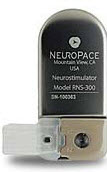- News
- Responsive neurostimulation, cooling and targeted drug delivery for epilepsy
Responsive neurostimulation, cooling and targeted drug delivery for epilepsy
 A new generation of implantable devices called the "Closed-loop" devices are designed to monitor the seizure focus, detect patterns of electrical activity suggestive of seizures, and automatically respond in the form of electrical stimulation , cooling or focused drug delivery inorder to interrupt and stop the seizure activity.
A new generation of implantable devices called the "Closed-loop" devices are designed to monitor the seizure focus, detect patterns of electrical activity suggestive of seizures, and automatically respond in the form of electrical stimulation , cooling or focused drug delivery inorder to interrupt and stop the seizure activity.
The Vagal Nerve Stimulator (VNS) is on the other hand an open-loop device that stimulates the vagus nerve and deliver consistent mild electrical pulses to the brain. Unlike closed loop devices it does not stimulate in response to a seizure. Cyberonics' Vagus Nerve Stimulator (VNS) has had FDA approval for treatment of epilepsy since 1997.
NeuroPace's Responsive Neurostimulation System (RNS), is an example for a closed-loop device that has now reached human-trials. The RNS electrical-stimulation implant has two leads, each containing four electrodes, which are placed in the brain at the seizure focus.
The RNS detects electrical activity that denotes the start of a seizure and delivers direct electrical stimulation to interrupt the activity and normalize the area. The device is surgically positioned in the skull and can be accessed via outpatient surgery in order to change batteries etc. The device is also capable of recording continuous information on the electrical activity of the brain and has a laptop-based wand interface for remote patient monitoring.
However the RNS trial where the device was tested in conjunction with medications, have only given mixed results with the seizure frequency reduced by about half in only approximately half of the patients studied.
There is also on going research to turn the VNS into a closed-loop device by developing a non implanted add-on system to detect early seizure activity and automatically fire the VNS in response. The therapy magnet wristband which comes with the VNS could be used by the wearer to stimulate the device if they feel a seizure coming on . However not everyone who suffer from seizures is able to physically stimulate the device even if they feel an aura.
The Center for Integration of Medicine and Innovative Technology (CIMIT ) at Boston is working on a way of automating this process, activating the VNS once the start of a seizure by detecting changes in EEG or ECG.
Focal cooling: The closed loop device can also after detecting the onset of a seizure by sensing a rise in brain temperature at the seizure focus, can rapidly cool the involved region in order to stop the seizures. This can be more advantageous since the rise in temperature may happen slightly before the onset of abnormal electrical activity.
 ,Ivan Osorio Professor Ivan Osorio University of Kansas Medical Center is currently collaborating with an international research partnership to design a prototype implant with funding from the U.S. Department of Energy. Research on similar projects is also happening at Yale and Minnesota universities.
,Ivan Osorio Professor Ivan Osorio University of Kansas Medical Center is currently collaborating with an international research partnership to design a prototype implant with funding from the U.S. Department of Energy. Research on similar projects is also happening at Yale and Minnesota universities.
Targeted drug delivery: The closed-loop devices could also use convection-enhanced drug delivery (CED) .Here the antiepileptic drugs are delivered directly to specific brain areas through an implanted catheter. The device could also be used to deliver a regular infusion of the drug which migh be more helpful than triggering in response to a seizure.
Michael Rogawski, chair of neurology at the University of California, Davis, whose lab is working with British Columbia–based biopharmaceutical company MedGenesis Therapeutix to develop an implantable CED device for epilepsy.
Devices which are used for Deep Brain Stimulation are also open-loop devices where the implanted devices is used to consistently stimulate the anterior nucleus of the thalamus in order to control the cortical electrical excitability. DBS might be helpful in patients where the seizure activity originates from a widespread area
However there are several risks associated with these implantable devices. The main concern besides those inherent with the surgery, are regarding false positives, where beneficial electrical activity is falsely interrupted upon. Clearly the challenge is to devise a gadget which can predict the seizures accurately, early and act fast enough to stop them.
Source: Scientific American
Read More